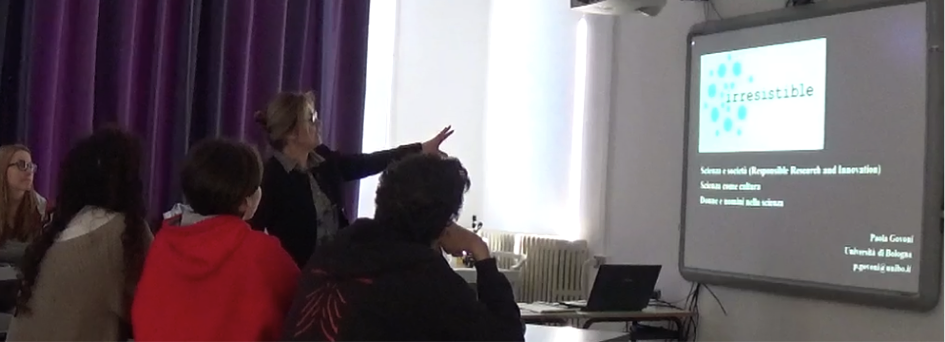At the end of 2014 the University of Bologna Irresistible team asked me to join the group in order to discuss RRI issues with the boys and girls involved in the second phase of the project.
I am a historian that uses gender and social studies of science to understand the relationships between science and society, and I introduced to the teens I encountered the issues my field is working on: what is science? what do scientists (men and women) do, and why? while the role science and technology have played in our societies for the last four centuries is generally agreed upon, why is it so difficult to accept and discuss the role played by society and culture – including gendered culture – in shaping, organizing, and innovating science?
I met with 109 boys and 32 girls aged 15 to 18 from five schools (one vocational school is attended only by boys). The schools have different goals and organization, and therefore the students’ social backgrounds are different, so I used different powerpoint slides from school to school. I initially explained to the students that our meeting was intended to develop a discussion that could prove to be useful, in an independent and critical manner, for their work on RRI in nanotechnology. I suggested that, instead of discussing the pros and cons of nanotech in specific, we experiment with what it means to critically examine an issue we define as social (i.e. gender issues; the social responsibility of the scientist) in order to discuss it in relation to the science itself.

Paola Govoni shows to the students her powerpoint presentation
Since I had only two hours for each class, it was necessary to find a way that would permit the students to quickly familiarize themselves with the issues we were to discuss. I decided a short questionnaire would serve this purpose well. The teenagers took 7-10 minutes to complete the questionnaire.

The students fill in the questionnaire
Once completed, I asked them to choose the topic they preferred to use to start the discussion. The questions they found most interesting were:
- Do you think politics, economics, religion, and whether the scientist is a woman or a man can influence science and laboratory work?
☐Yes ☐No
- Close your eyes and imagine a laboratory. You mostly see:
☐women ☐men ☐both
For each topic I had data which I used during the discussion in order to address concrete cases. Regarding the relationship between gender and science the initial question was: why are there countries like Italy in which girls perform poorer than boys in math, while in other countries girls have an equal or superior performance to boys? We gave an answer confronting the PISA with the World Economic Forum/Global Gender Gap data.
Another topic the students found stimulating was science’s role in society in relation to the social responsibility of the scientist. The beginning questions were:
- Do you feel that science and technology have contributed to humanity in a positive or negative way?
- The challenges that humanity faces, such as providing food and energy for billions of people, will be resolved by:
☐scientists ☐politicians ☐scientists, politicians and citizens together
These topics spurred discussions that were far from trivial or predictable. I let the students speak about this event, stepping in every now and then simply to indicate different points of view and give them more information. This method seemed to have worked in making them aware of the fact that the relationships between experts, power and society are immensely complex in a way that not only concerns us personally, but are also not resolved by taking an ideological stance on the issue. A topic not resolved by invoking “ethics” or “morals”, abstract concepts that vary with time, from person to person, from society to society. We brought the discussion to the present. In fact, not only was I lucky to meet one class the day after the press conference announcing the first direct detection of gravitational waves, but in general I met the five classes in the period of the public discussion on CRISPR-Cas9 (development of efficient and reliable ways to make precise, targeted changes to the genome of living cells is a long-standing goal for biomedical researchers). The CRISPR case was very useful to us because of its controversial nature and the fact that the protagonists are two women, Jennifer Doudna and Emmanuelle Charpentier. It was easy, based on daily science news such as these episodes, to involve these brilliant boys and girls in discussions about science as a social culture.
By starting with questions, I tried to illustrate what it means to use a critical approach towards social issues in science and technology. In particular, I tried to bring their attention to the difficult problem of selecting valid sources. I asked them to proceed in a similar and independent manner when dealing with pros and cons of nanotechnology. Objective: avoid cut-and-paste from the internet containing information in which the benefits/risks of the research addressed are already decided; avoid resorting to the rhetoric of “ethics” without attaching it to data, examples and concrete historic or social circumstances.
At this point, in the final phase of the project, we must verify whether the experiment has been successful.








